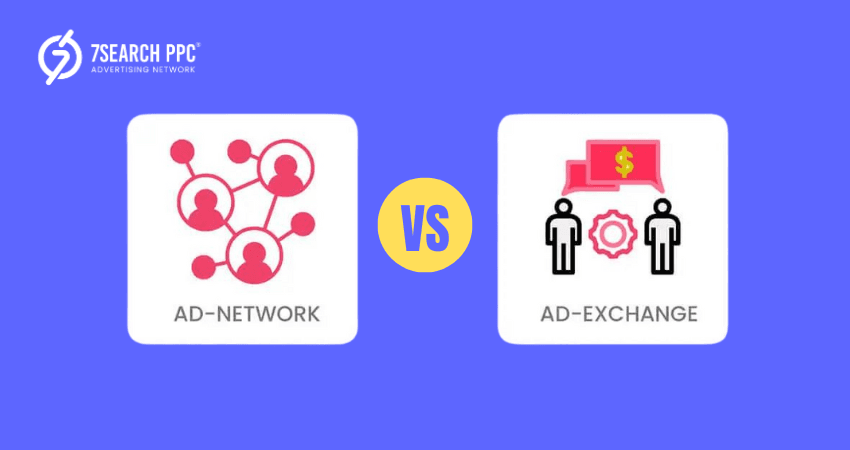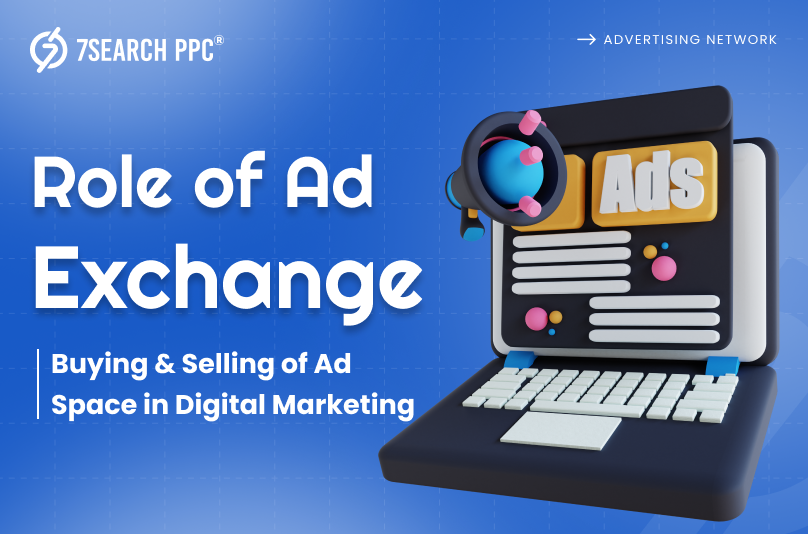When you browse your favorite website and see an ad that perfectly matches your interests, have you ever wondered how that happens? Allow us to introduce you to Ad Exchange—a digital marketplace where advertisers and publishers gather to buy and sell advertising space in real-time. Advertising exchanges play a notable role in making sure that the right ad gets to the right person at the right time.
They use advanced algorithms and large amounts of data to seamlessly match ads with users’ preferences. This not only improves the user experience by showing relevant content but also maximizes revenue for publishers and provides effective outreach for advertisers.
This blog has numerous things for you to learn, such as how advertising exchanges function and why they are known as the backbone of modern online advertising strategies.
Ad Exchange: The Crowded Marketplace of Online Ads
An advertising exchange is an online platform that acts as a marketplace where advertisers and publishers meet to buy and sell ad space. It connects sellers (publishers) using Supply-Side Platforms (SSPs) with buyers (advertisers) using Demand-Side Platforms (DSPs).
There are two types of ad exchanges:
- Open Exchanges
- Private Marketplaces
Open exchanges are accessible to all buyers and sellers, allowing anyone to bid on ad space. Private marketplaces, on the other hand, are exclusive, invite-only platforms where premium buyers and sellers participate in private auctions for advertising space.
In essence, an ad exchange facilitates the buying and selling of ads in real-time, offering both open and private options for transactions.
Benefits of Utilizing an Ad Exchange in Digital Advertising
Utilizing an advertising exchange in online advertising offers several key benefits:
Benefits for Advertisers:
- Targeted Visibility: Ad exchanges use advanced algorithms to identify and reach specific audiences. This means that ads are shown to people who are most likely to be interested in them. By targeting the ideal audience, advertisers can increase the chances of their ads being noticed before their competitor’s ads.
- Streamlined Ad Distribution: With advertising exchanges, advertisers can place ads across many different websites and apps at once. This saves time and effort compared to negotiating with each site individually. It allows advertisers to quickly spread their message to a large audience. Overall, it improves the efficiency of their ad campaigns with a rapid reach.
- Brand Safety: Ad exchanges support advertisers in every possible way. Advertisers can decide where their ads will be shown so they can ensure their brand is displayed in a safe and appropriate place. This control helps avoid placing ads on sites that might harm their brand’s image or reach an irrelevant audience. Advertising exchanges maintain the effectiveness and integrity of advertisers’ campaigns.
Benefits for Publishers:
- Transparent Bidding System: An advertising exchange uses a transparent bidding system where advertisers compete for ad space. This competition helps publishers get the highest possible price for their ad space. Publishers can also set a minimum price they are willing to accept. It ensures they receive fair value for their ad space.
- Ad Selection: Publishers can select which ads appear on their site. This choice helps them avoid ads that might not be suitable or relevant for their audience, protect their brand’s reputation, and ensure that the ads fit well with their site’s content.
- Ad Format Control: Publishers have the power to decide how ads are displayed on their site or app. This means they can choose formats that match their site’s design and user experience. By controlling the ad format, publishers ensure that online ads are integrated smoothly rather than disrupt the overall site layout.
Ad Network vs. Ad Exchange: Are They Similar?
Not you, but in fact, many of us are confused with the term ‘Ad Network’ vs. ‘Ad Exchange.’ Both terms are related but not the same. An advertising exchange works like a marketplace where advertisers and publishers trade ad space directly. It’s a platform where real-time bidding occurs, and the highest bidder gets the ad spot.

In contrast, an ad network serves as a middleman in this process. It collects ad space from various publishers and packages it for advertisers.
The network then matches the advertisers with the available ad space, either from its own inventory or by purchasing it in bulk from advertising exchanges. This helps advertisers save time by finding the right spots without having to search themselves.
The Function of Ad Exchanges in Digital Advertising
Effective programmatic advertising depends on placing ads in front of the right people. This only happens through advertising exchange, but how does it work? Don’t know? That’s why we have researched the functions of advertising exchanges:
- Publisher Lists Inventory: A publisher makes their ad space available on the ad exchange using a platform called SSP. They provide details about the ad space, like its location on the page, audience info, and topics covered.
- User Visits Site: When a user visits the publisher’s website or app, the available ad space is put up for auction. The user’s data is collected and delivered to the publisher’s server and then transferred to the ad exchange.
- Bid Requests: The ad exchange sends out requests to Demand-Side Platforms (DSPs) and Ad networks. These platforms check the bid request details—like user demographics and location—to decide if they want to bid on the ad space.
- Bidding: Each DSP or Ad Network places a bid on the ad space if they’re interested. They also specify how much they are willing to pay and which ad they want to display.
- Selection: The Ad exchange reviews all the bids and filters out those that don’t meet the publisher’s criteria.
- Winning Bid: The ad exchange picks the highest bid and shows the advertiser’s ad in the available ad space. The process is so quick—lasting just milliseconds—that users don’t notice it or experience any delay.
How to Select the Right Ad Exchange for Your Needs
We have learned the meaning, types, and role of an ad exchange. But how do you find and bet on the right one? Selecting the ideal advertising exchange is essential for enhancing your advertising strategy and reaching your objectives. You can follow this step-by-step guide to identify the most suitable advertising exchange for your requirements:
Broad Size
When selecting an advertising exchange, prioritize those that offer access to a large network of publishers or advertisers. For advertisers, this means your online ads can reach a wider audience, increasing their campaign’s impact.
For publishers, it provides a variety of brands to feature, helping to better match ads with their site’s audience. A broad reach helps both parties connect effectively and maximize their advertising or monetization goals.
Targeting Features
Let’s move toward the next step. You need to check if the chosen ad exchange has strong targeting features or not. Effective targeting features help you narrow down your audience based on numerous factors, such as:
- Age
- Location
- Interest
For advertisers, this means their digital ads can be shown to the people who are most likely to be interested in their brands. For publishers, it means displaying ads that are relevant to their users.
Supported Ad Formats
Does your advertising exchange support your desired ad format? Make sure it supports the types of ads you want to use, like banners, text, or native ads.
Having a variety of ad formats gives advertisers more creative options for their campaigns, allowing them to choose the best way to present their message. For publishers, a variety of ad formats offer ways to earn significant money. More choices regarding ad format help both advertisers and publishers maximize ad revenues or profits.
Accurate Data
Data in digital advertising is like a report card that shows what you get from your advertising efforts. You must research an advertising exchange that offers detailed real-time data and analytics. This information helps you understand how your ads are performing, and from this information, you can easily make adjustments for better results.
With accurate data, you can get an idea about each detail that you can use to improve your ad campaigns. It can also help you develop future strategies for optimal results and save your budget.
Fraud Protection Measures
Fraudsters are everywhere and can harm your entire advertising efforts. You can show trust in an advertising exchange that has strong fraud protection measures in place. This means the ad exchange checks the quality of ads to make sure they’re genuine, ensures clicks are tracked fairly, and blocks any suspicious or harmful sources.
These measures help prevent fraudulent activity, protect your advertising budget from being wasted, and safeguard your reputation. Effective fraud protection ensures that your ads reach real users and that your campaigns get accurate results.
Conclusion
Ad exchanges are essential for modern online advertising. They connect advertisers and publishers, allowing them to buy and sell ad space efficiently. By using real-time bidding and detailed data, advertising exchanges make sure that ads reach the right people at the right time. This benefit helps advertisers by improving ad targeting and efficiency and helps publishers get better rates for their ad space. To get the most out of an advertising exchange, choose one that offers a broad network, strong targeting features, various ad formats, accurate data, and good fraud protection. This way, you can get the best result through the advertising exchanges.
Frequently Asked Questions (FAQs)
What is an ad exchange?
Ans. An advertising exchange is an online platform where advertisers and publishers gather in a digital space to trade advertising space in real-time.
How does an ad exchange work?
Ans. An advertising exchange works by auctioning off ad space on websites and apps to the highest bidder. This happens in real-time, ensuring ads are shown to the right users.
What are the types of ad exchanges?
Ans. There are two main types of advertising exchanges: open exchanges, which are open to everyone, and private marketplaces, which are invite-only platforms for exclusive participants.
What is the role of data in ad exchanges?
Ans. Data helps advertising exchanges understand users’ preferences, enabling them to show relevant ads. It also allows advertisers and publishers to track the performance of their ads.
What are Supply- Side Platforms (SSPs) and Demand-Side Platforms?
Ans. SSPs are used by publishers to put their ad space for sale, while DSPs are used by advertisers to bid on and buy ad space in real-time.


















